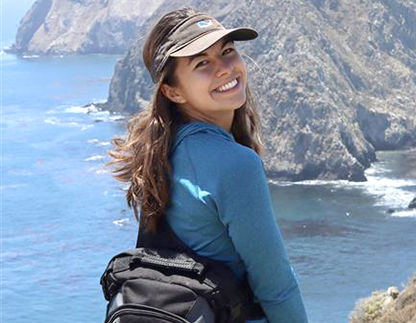I am inspired by the beauty and resilience of the natural world.”
Kyla Knauf
PhD Candidate in the Department of Plant Biology and Conservation

Kyla Knauf is a PhD candidate in the Department of Plant Biology and Conservation in the Weinberg College of Arts and Sciences. She researches the effects of early snowmelt on plant reproduction.
How would you describe your research and/or work to a non-academic audience?
My research looks into how earlier snowmelt due to climate change is affecting wildflower populations. Specifically, I am studying how earlier snowmelt is changing the timing of when plants are reproducing (flowering and fruiting), as well as how successful their reproduction is, using experimental plots in the Rocky Mountains of Colorado.
As earlier snowmelt can expose plants to new conditions, such as colder air temperatures or less pollinators, we expect potential population-level effects in the future. However, we also know that plants can be resilient and adapt to new environments, which is why research is needed to understand how plants are actually responding to this change.
What is the biggest potential impact or implication of your work?
While two of my dissertation chapters are more focused on furthering our basic knowledge of plant reproduction under climate change, my third chapter aims to have a more direct impact by working with Glacier National Park. Here, I am using 30+ years of seed collection data from the park's past restorations and combining it with historical climate data to help park rangers better predict when is the best time to collect seeds throughout the park. I am currently working on the analysis for this, but am excited to eventually present this work to park staff and visitors!
Why Northwestern?
As a sophomore in undergraduate, I participated in the REU program in Northwestern's Plant Biology and Conservation Department. Not only did I have a transformational ecological research experience, but I also had an unforgettable experience bonding with like-minded peers and getting to know the Chicagoland area. Since then, I knew that I wanted to return to Northwestern for graduate school.
How do you unwind after a long day?
After a long day, I love to spend time with my puppy Culver. If it's nice out, I love to take Culver on walks or to the dog beach, and when it's cold out, we cuddle and watch TV. I also love being creative—some of my favorite things to do are making stained glass art, crocheting, and baking desserts.
What inspires you?
Broadly, I am inspired by the beauty and resilience of the natural world, from delicate woodlands and prairies like those found in the Chicagoland area, to the vast mountains and deserts of the American West. I am also very inspired by those who advocate for public land access and protection, such as our park rangers and local policymakers. While my current work focuses on the science aspect of ecology, I aspire to have a future career where I more directly work to ensure that these places persist forever.
What did you originally want to be when you grew up?
I have always gravitated towards an environmental career, and as a child I wanted to be a meteorologist. Like many, I was fascinated by storm books, shows, and extreme weather in my own backyard. However, reality hit me when I realized how integral math, chemistry, and physics was to atmospheric sciences during an undergraduate research experience, and I opted for a route that would have me more directly outside (ecology) instead.
Publish Date: July 1, 2025
If you know a graduate student, postdoctoral scholar, graduate faculty member, staff member, or a member of our TGS alumni population who would make a great candidate for our TGS Spotlight Series, please complete this brief TGS Spotlight Series Nomination Form.